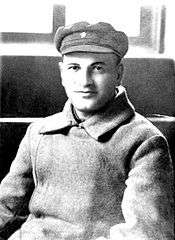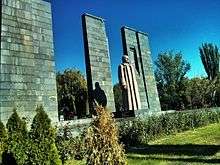Alexander Miasnikian
| Alexander Miasnikian | |
|---|---|
 | |
| Chairman of the Council of People's Commissars of Armenia | |
|
In office 1 January 1921 – 30 January 1922 | |
| Head of the Communist Party of Belarus | |
|
In office 1918–1919 | |
| Personal details | |
| Born |
9 February 1886 Nor Nakhichevan, Don Voisko Oblast, Russian Empire |
| Died |
22 March 1925 (aged 39) near Tiflis, Soviet Georgia |
| Nationality | Armenian |
| Political party | Communist Party of the Soviet Union |


Alexander Miasnikian, Myasnikyan[1] or Myasnikov (Armenian: Ալեքսանդր Մյասնիկյան; Russian: Алекса́ндр Фёдорович Мяснико́в; Alexander Fyodorovich Myasnikov; 28 January [9 February] 1886 – 22 March 1925) was an Armenian Bolshevik revolutionary and official. Myasnikyan's revolutionary nom de guerre was Martuni.
Biography
Myasnikyan was the son of a merchant. He graduated from the law department of Moscow University in 1911. As a student in Nakhichevan and later in Moscow, Myasnikyan was active in underground groups beginning from 1901 and formally became a member of the revolutionary movement in 1904. He was arrested and exiled to Baku in 1906.[2]
Between 1912 and 1914, Myasnikyan worked as an assistant to a lawyer in Moscow and participated in disseminating political literature. He was drafted into the Russian Army in 1914, where he promoted revolutionary ideas among the soldiers.
After the February Revolution of 1917, Myasnikyan became a member of the Western Front's frontline committee and was an editor of the Bolshevik newspaper Zvezda in Minsk. He was elected as a delegate for the 6th Congress of the Bolshevik Party. He became chairman of the Northwestern Regional Committee of the Bolshevik Party, and became part of the Military Revolutionary Committee of the Western Region. Myasnikyan was elected the commander of the Western Front at the congress of deputies.
In 1918, he became the first chairman of the Communist Party of Byelorussia. From 4–27 February 1919, Myasnikyan was chairman of the Central Executive Committee of the Socialist Soviet Republic of Byelorussia that briefly existed in January and February of that year. He was a member of the Central Committee of the Bolshevik Party for the short-lived Lithuanian–Belorussian Soviet Socialist Republic.
When Nikolai Krylenko was appointed Supreme Commander in Chief of the Red Army, he in turn appointed Myasnikyan as his deputy.[3]
In 1921, after the February Uprising, he was appointed Chairman of the Council of People's Commissars of Armenia, the newly installed government of the Armenian Soviet Socialist Republic. After being appointed as a head of government during the early years of the Armenian Soviet Republic, Myasnikyan was instrumental in the formation of state institutions and economy of the republic. Myasnikyan also initiated active work towards eradicating the illiteracy and developing local manufacturing in Armenia.
Myasnikyan wrote several works about the theory of Marxism-Leninism, the history of the revolutionary movement, and Armenian literature. He began writing reviews for theater in 1906. His works about Armenian literature include the article "Mikael Nalbandian" and pamphlets on the poetry of Hovhannes Hovhannisyan and Hovhannes Tumanyan. In literature, Myasnikyan criticized apolitical approaches to literature and the concept of "art for art's sake" in articles like "Philanthropy and its Lackeys" (1912).[2]
Death
Myasnikyan was killed in a mysterious plane crash on 22 March 1925, along with Solomon Mogilevsky, Georgi Atarbekov, the pilot and flight engineer. They had been on their way to Sukhumi for an Abkhazia communist conference. Shortly after taking off from Tiflis, the Junkers F.13 aircraft caught fire. According to eyewitness reports, people were seen jumping to their deaths to escape the burning plane.[4]
The cause of the fire was never established, despite separate investigatory commissions chaired by Lavrenty Beria (first) and Karl Pauker (second and third). Nothing was found to be wrong with the plane mechanically.[4] Leon Trotsky, who left Sukhumi for the funeral in Tiflis, was suspicious of the cause of the crash.[5] Others who believed it was deliberate suspected Beria himself organized it.[1]
Legacy
Myasnikyan is one of the few communist leaders still celebrated in Armenia after the dissolution of the Soviet Union. A monument is situated in the center of Yerevan commemorating him.
Several locations within the Soviet Union were named after him (including "Martuni", his nom de guerre): In Armenia, a city and two villages (in Gegharkunik and Armavir provinces). In Russia's Rostov Oblast, an Armenian-populated raion (district) is called after him. In the disputed Nagorno-Karabakh Republic, a city and a province are called Martuni.
Galery
The portrait of Alexander Myasnikyan (Sculptor - Rafik Khachatryan, KHACHAR, 1937-1993)
References
- 1 2 "Former Prime Ministers". Government of the Republic of Armenia. Retrieved 8 July 2015.
- 1 2 Miasnikov, Aleksandr Federovich. Great Soviet Encyclopedia
- ↑ From Tsarist General to Red Army Commander by Mikhail Bonch-Bruyevich, translated by Vladimir Vezey, Progress Publishers, 1966, p. 232
- 1 2 Yevgeny Zhirnov (8 September 2008). "Нелепая и чудовищная катастрофа" ["Absurd and Monstrous Catastrophes"]. Kommersant (in Russian). Retrieved 14 February 2015.
- ↑ Stephen Kotkin (2014). Stalin: Volume I: Paradoxes of Power, 1878-1928 (ePub ed.). Penguin Press. pp. 2615–2616. ISBN 978-1594203794.
Further reading
| Wikimedia Commons has media related to Alexander Myasnikyan. |
- Александр Фёдорович МЯСНИКОВ
- Энциклопедия фонда "Хайазг" - Мясников Александр Фёдорович
- Энцыкляпедыя Электронная